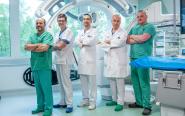We're hiring ! Join us and make a difference in our hospitals
Interventional radiology
Contact
Our role
Interventional radiology is a set of techniques that are minimally invasive and use medical imaging to visualise, access and act on an organ for the purposes of diagnosis and/or treatment.



We use ultrasound, angiography, scanners and sometimes MRI to carry out biopsies or ablations, place a stent or inject a treatment. In principle, this is possible for all the systems and most of the organs of the human body.
Our specialities
The H.U.B’s Interhospital Department of Interventional Radiology is divided into 5 sections:
- Vascular disease and embolization covers arterial or venous angiography and angioplasty (placing of a stent and prosthesis, in cooperation with vascular surgery) and embolization. The latter consists of blocking a blood vessel for therapeutic purposes, to stop haemorrhaging for example.
- The osteoarticular section covers infiltrations, biopsies, the thermoablation of bone tumours and cementoplasty (injection of intraosseous “cement”) with or without percutaneous osteosynthesis, in cooperation with orthopaedic surgery.
- The nephrology, urology and gynaecology sector covers the embolization of uterine fibroids, of benign prostatic hypertrophy and of pelvic varicoceles and varicose veins, as well as nephrostomy. This section also provides vascular access for dialysis and creates arteriovenous fistula by percutaneous means.
- The oncological section permits the placing of implantable ports and PICC lines (venous access), pain management through infiltration, neuroloysis or radiofrequency as well as the treatment of certain cancers (see Focus).
- The thoracic pathologies section covers biopsies, haemostatic embolization, percutaneous ablation of lung tumours and thermoablation of benign thyroid nodules.
Interventional radiology also covers biopsies and drainage under ultrasound, radiological or tomodensitomety (scanner) control.
Our team

Our specialists

Focus
Interventional radiology is used for a minimally invasive treatment of certain cancers and benign tumours. A number of techniques are proposed:
- The destruction of liver, kidney and lung tumours by thermoablation (radiofrequencies, microwaves and cryotherapy);
- Chemoembolization, radioembolization and portal embolization;
- Thermoablation of benign thyroid nodules ;
- Embolization of prostatic arteries in the framework of benign hypertrophy of the prostate gland.